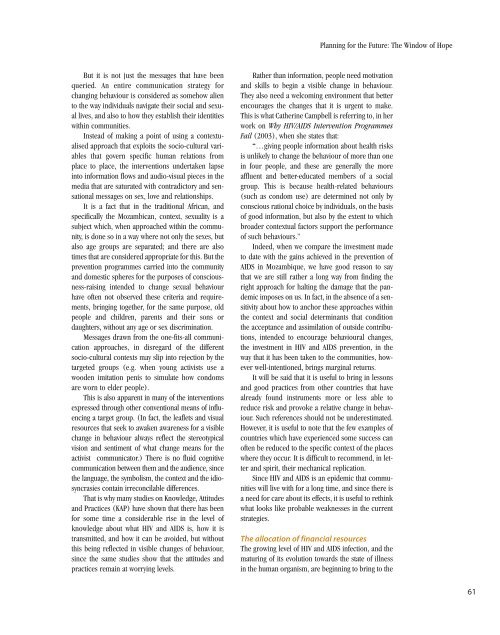English language version - Human Development Reports - United ...
English language version - Human Development Reports - United ...
English language version - Human Development Reports - United ...
- No tags were found...
Create successful ePaper yourself
Turn your PDF publications into a flip-book with our unique Google optimized e-Paper software.
Planning for the Future: The Window of HopeBut it is not just the messages that have beenqueried. An entire communication strategy forchanging behaviour is considered as somehow aliento the way individuals navigate their social and sexuallives, and also to how they establish their identitieswithin communities.Instead of making a point of using a contextualisedapproach that exploits the socio-cultural variablesthat govern specific human relations fromplace to place, the interventions undertaken lapseinto information flows and audio-visual pieces in themedia that are saturated with contradictory and sensationalmessages on sex, love and relationships.It is a fact that in the traditional African, andspecifically the Mozambican, context, sexuality is asubject which, when approached within the community,is done so in a way where not only the sexes, butalso age groups are separated; and there are alsotimes that are considered appropriate for this. But theprevention programmes carried into the communityand domestic spheres for the purposes of consciousness-raisingintended to change sexual behaviourhave often not observed these criteria and requirements,bringing together, for the same purpose, oldpeople and children, parents and their sons ordaughters, without any age or sex discrimination.Messages drawn from the one-fits-all communicationapproaches, in disregard of the differentsocio-cultural contexts may slip into rejection by thetargeted groups (e.g. when young activists use awooden imitation penis to simulate how condomsare worn to elder people).This is also apparent in many of the interventionsexpressed through other conventional means of influencinga target group. (In fact, the leaflets and visualresources that seek to awaken awareness for a visiblechange in behaviour always reflect the stereotypicalvision and sentiment of what change means for theactivist communicator.) There is no fluid cognitivecommunication between them and the audience, sincethe <strong>language</strong>, the symbolism, the context and the idiosyncrasiescontain irreconcilable differences.That is why many studies on Knowledge, Attitudesand Practices (KAP) have shown that there has beenfor some time a considerable rise in the level ofknowledge about what HIV and AIDS is, how it istransmitted, and how it can be avoided, but withoutthis being reflected in visible changes of behaviour,since the same studies show that the attitudes andpractices remain at worrying levels.Rather than information, people need motivationand skills to begin a visible change in behaviour.They also need a welcoming environment that betterencourages the changes that it is urgent to make.This is what Catherine Campbell is referring to, in herwork on Why HIV/AIDS Intervention ProgrammesFail (2003), when she states that:“…giving people information about health risksis unlikely to change the behaviour of more than onein four people, and these are generally the moreaffluent and better-educated members of a socialgroup. This is because health-related behaviours(such as condom use) are determined not only byconscious rational choice by individuals, on the basisof good information, but also by the extent to whichbroader contextual factors support the performanceof such behaviours.”Indeed, when we compare the investment madeto date with the gains achieved in the prevention ofAIDS in Mozambique, we have good reason to saythat we are still rather a long way from finding theright approach for halting the damage that the pandemicimposes on us. In fact, in the absence of a sensitivityabout how to anchor these approaches withinthe context and social determinants that conditionthe acceptance and assimilation of outside contributions,intended to encourage behavioural changes,the investment in HIV and AIDS prevention, in theway that it has been taken to the communities, howeverwell-intentioned, brings marginal returns.It will be said that it is useful to bring in lessonsand good practices from other countries that havealready found instruments more or less able toreduce risk and provoke a relative change in behaviour.Such references should not be underestimated.However, it is useful to note that the few examples ofcountries which have experienced some success canoften be reduced to the specific context of the placeswhere they occur. It is difficult to recommend, in letterand spirit, their mechanical replication.Since HIV and AIDS is an epidemic that communitieswill live with for a long time, and since there isa need for care about its effects, it is useful to rethinkwhat looks like probable weaknesses in the currentstrategies.The allocation of financial resourcesThe growing level of HIV and AIDS infection, and thematuring of its evolution towards the state of illnessin the human organism, are beginning to bring to the61
















